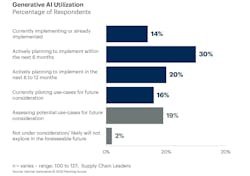Top Supply Chain Companies Use AI at Twice Rate of Peers
In a new survey by Gartner, top performing supply chain organizations are investing in artificial intelligence and machine learning to optimize their processes at more than twice the rate of low performing peers.
The survey also revealed that the best supply chain organizations are using productivity, rather than efficiency or cost savings, as their key focus to sustain business momentum over the next three years.
“Top performing supply chain organizations make investment decisions with a different lens than their lower performing peers,” said Ken Chadwick, VP Analyst in Gartner's Supply Chain practice. “Enhancing productivity is the key factor that will drive future success and the key to unlocking that productivity lies in leveraging intangible assets. We see this divide especially in the digital domain where the best organizations are far ahead in optimizing their supply chain data with AI/ML applications to unlock value.”
In the survey the data showed that high-performing organizations are far ahead in automating and/or optimizing processes that utilize supply chain data using AI and ML.
Supply Chains Must Extract Value from Intangible Assets
Top performers increasingly prioritize extracting value from their digital assets to drive productivity, rather than making digital investments to achieve efficiencies such as cost savings.
Among the top five digital investments expected to deliver value, high performers are farther along in implementation across the board. These include (high performing vs. low performing organizations):
- Partner with IT to establish unbreachable data security mechanisms (74% vs. 61%)
- Create ethical and binding data privacy frameworks for use of customer data (68% vs. 50%)
- Write cybersecurity measures into supplier and staff contracts (66% vs. 57%)
- Capture supply chain specific customer satisfaction data (58% vs. 40%)
- Analyze and leverage supply chain specific customer use and satisfaction data (57% vs. 35%)
“Capturing, protecting and then leveraging an organization’s data through the use of AI/ML is an example of how organizations are increasingly turning towards intangible assets to extract new sources of value,” said Chadwick. “High performing organizations are moving beyond the initial implementation stage to full adoption, resulting in better decision making that unlocks new sources of value.”
Gartner’s survey found similar trends in how top performing supply chain organizations are achieving intangible value from their people and resource investments. Chadwick noted that rapid tech advancement will drive the necessity for organizations to upskill their talent, with investments in learning and development needed to achieve the full benefits of the organization’s digital investments.
When managing resource investments, top performing organizations were far ahead in collaborating with suppliers to maintain supplier consistency and working exclusively with suppliers that have their own risk controls. These characteristics are typical of organizations that have achieved increased supplier visibility through the use of mature data and analytics capabilities.

